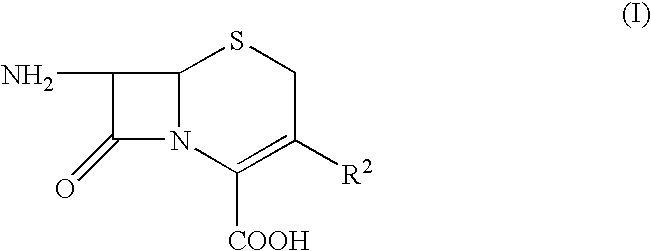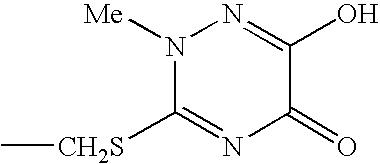Process for producing Cefepime and cephalosporin analogues
a technology of cephalosporin and cephalosporin, which is applied in the field of process for preparing cefepime and cephalosporin analogues, can solve the problems of impracticality of benzathine salt alternatives, inability of benzathine to salify carboxyl,
- Summary
- Abstract
- Description
- Claims
- Application Information
AI Technical Summary
Benefits of technology
Problems solved by technology
Method used
Image
Examples
example 1
Preparation of the Compound of Formula VI
7-[4-chloro-3-oxo-2-methoxyiminobutanoyl]amino]-2-carboxy-8-oxo-5-thia-1-azabicyclo[4.2.0]oct-2-ene-3-methyl-(1-methylpyrrolidinium)chloride
[0029]Two separate solutions are prepared.
[0030]Solution A:
[0031]4g of (6R,7R)-7-amino-3-(1-methyl-1-pyrrolidinium)methyl-ceph-3-em-4-carboxylate hydrochloride (compound of formula III) (M.W. 333.92) are suspended in 150 ml of acetonitrile and cooled to +10° C. 0.1 ml of methanesulfonic acid are added followed by 8.6 g of N,O-bistrimethyl-silyl-acetamide (M.W. 203.43) allowing the temperature to rise spontaneously and freely. The mixture is stirred for 90 minutes at +33 / +35° C. until a solution forms, and then cooled to −40° C.
[0032]Solution B:
[0033]1.4 ml of N,N-dimethylformamide are added to 30 ml of acetonitrile, the temperature is brought to +25° C., then after allowing it to rise to +36° C. 1.6 ml of phosphorus oxychloride (M.W. 153.33- d=1.675) are added. The mixture is stirred for 15-20 minutes at ...
example 2
Preparation of Cefepime Hydrochloride Monohydrate
[0036]5.8 g of the compound of formula (VI) obtained in Example 1 are suspended in 50 ml of water at +20 / +25° C. 1.8 g of thiourea are added, the temperature is maintained at +20 / +25° C., 5.9 g of sodium acetate are added and the mixture is stirred at this temperature for 3 hours. On termination of the reaction 240 ml of acetone are added. 35% hydrochloric acid is added at +20 / +25° C. until pH 1.5 is attained. A further 360 ml of acetone are added dropwise over 1 hour, then the mixture is stirred for 30 minutes at +20 / +25° C., cooled to 0° C. and stirred for 1 hour. The mixture is filtered and the product washed with 250 ml of acetone, then dried at +30° C. under reduced pressure. 6.3 g (93% yield) of Cefepime hydrochloride monohydrate are obtained, presenting the following spectrum:
[0037]1H NMR (DMSO-d6, 300 MHz): 9.8, (1H, d); 6.8, (1H, s); 5.85, (1H, dd); 5.36, (1H, d); 4.6 and 4.4, (2H, AB system, JAB=14 Hz); 4.1 and 3.7, (2H, AB ...
example 3
Preparation of Cefepime Sulfate
[0038]5.8 g of the compound of formula (VI) obtained in Example 1 are suspended in 25 ml of water at +20° C. / +25° C. 1.8 g of thiourea are added, the temperature is maintained at +20 / +25° C., 5.9 g of sodium acetate are added and the mixture is stirred for 3 hours at +20 / +25° C. On termination of the reaction 90 ml of acetone are added.
[0039]The solution is cooled to 0° / +5° C. then brought to pH 1.8 with a solution consisting of 30% H2SO4 and acetone (1:2.5 v:v).
[0040]The solution is then stirred for 1 hour, filtered, washed with 50 ml of acetone and dried under reduced pressure at +30° C. 4.8 g (yield 72%) of Cefepime sulfate are obtained whose 1HNMR spectrum coincides with that of Cefepime hydrochloride.
[0041]By applying the same method to compounds of formula (III) in which R2 is chosen from the following group
[0042]
Cefpirome sulfate is obtained in the first case and Cefquinome sulfate in the second case.
PUM
| Property | Measurement | Unit |
|---|---|---|
| temperature | aaaaa | aaaaa |
| temperature | aaaaa | aaaaa |
| temperature | aaaaa | aaaaa |
Abstract
Description
Claims
Application Information
 Login to View More
Login to View More - R&D
- Intellectual Property
- Life Sciences
- Materials
- Tech Scout
- Unparalleled Data Quality
- Higher Quality Content
- 60% Fewer Hallucinations
Browse by: Latest US Patents, China's latest patents, Technical Efficacy Thesaurus, Application Domain, Technology Topic, Popular Technical Reports.
© 2025 PatSnap. All rights reserved.Legal|Privacy policy|Modern Slavery Act Transparency Statement|Sitemap|About US| Contact US: help@patsnap.com



